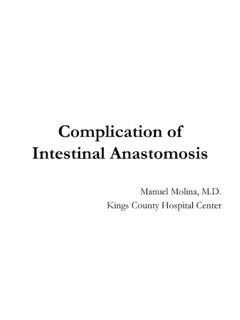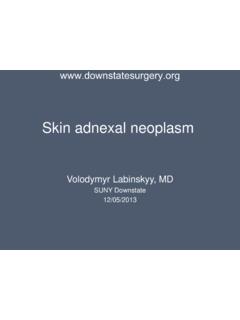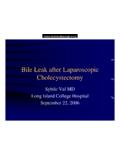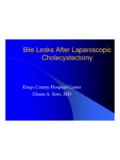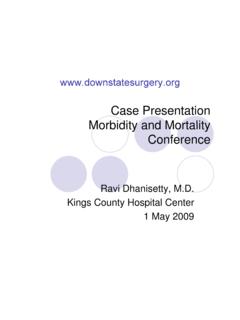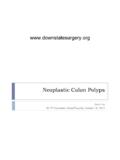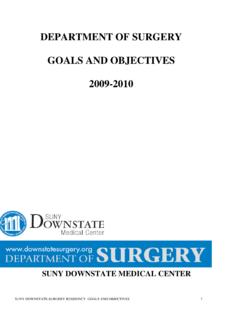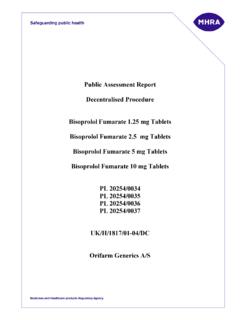Transcription of Perioperative Management of Antithrombotic Therapy
1 Perioperative Management of Antithrombotic Therapy Evaluate Perioperative continuation of antiplatelet agents ( , aspirin, clopidogrel) based on comorbidities, presence and type of coronary stents and cardiac risk of procedure. Consider Cardiology consult. Suggested Patient Risk Stratification for Perioperative Thromboembolism Indication for Warfarin Therapy Risk Level Mechanical Heart Valve Atrial Fibrillation Venous Thromboembolism High (> 10% risk arterial TE per year) Any mitral valve prosthesis Older (caged-ball or tilting disc) aortic valve prosthesis Recent (within 6 mo) stroke or TIA (> 10% risk arterial TE per year) CHADS2 score of 5 or 6 Recent (within 3 mo) stroke or TIA Rheumatic valvular heart disease Recent (within 3 mo) VTE Severe thrombophilia ( , deficiency of protein C, protein S or antithrombin, antiphospholipid antibodies, or multiple abnormalities) Moderate (4-10% risk arterial TE per year) Bileaflet aortic valve prosthesis and one of the following.
2 Atrial fibrillation, prior stroke or TIA, hypertension, diabetes, congestive heart failure, age > 75 years) (5-10% risk arterial TE per year) CHADS2 score of 3 or 4 VTE within the past 3 to 12 mo Nonsevere thrombophilic conditions Recurrent VTE Active cancer (treated within 6 mo or palliative) Low (< 4% risk of arterial TE per year) Bileaflet aortic valve prosthesis without atrial fibrillation and no other risk factors for stroke (< 5% risk of arterial TE per year) CHADS2 score of 0 to 2 (and no prior stroke or TIA) Single VTE occurred > 12 mo ago and no other risk factors TE = thromboembolic event; VTE = venous thromboembolic event; TIA = transient ischemic attack; mo = month CHADS2 = Congestive heart failure-Hypertension-Age-Diabetes-Stroke Adapted from: CHEST 2008; 133:299 339S. WARNING: SPINAL / EPIDURAL HEMATOMAS Enoxaparin use in patients undergoing neuraxial anesthesia (epidural/spinal anesthesia) or spinal puncture increases risk of developing epidural or spinal hematomas that may result in long-term or permanent paralysis.
3 Hold enoxaparin treatment doses > 24 hours before epidural needle/catheter insertion Hold enoxaparin prophylaxis doses > 12 hours before epidural needle/catheter insertion DO NOT remove catheter until > 12 hours after last enoxaparin dose DO NOT restart enoxaparin until > 2 hours after needle/catheter removal Pre-Procedure Day (For Procedures that Require Normalization of INR) 2 1 Risk of Perioperative Venous Thromboembolism (See Suggested Stratification Table Below) 5 4 3 If INR > , consider vitamin K mg PO Day of Surgery/Procedure Post-Procedure Management (AFTER Adequate Hemostasis) High Stop warfarin 5 days pre-op. Test INR 1-2 days prior to surgery. If INR > , consider vitamin K mg PO x 1 dose. Reassess INR on day of surgery. Bridge with treatment dose intravenous (IV) unfractionated heparin or subcutaneous (SC) enoxaparin. Last pre-op dose: - Stop IV heparin 4 h pre-op - 50% total dose enoxaparin 24 h pre-op ( , AM dose of enoxaparin 24 h pre-op if q12h regimen) Moderate Stop warfarin 5 days pre-op.
4 Test INR 1-2 days prior to surgery. If INR > , consider vitamin K mg PO x 1 dose. Reassess INR on day of surgery. Bridge with treatment dose IV unfractionated heparin or SC enoxaparin, or low-dose SC enoxaparin. Last pre-op dose: - Stop IV heparin 4 h pre-op - 50% total dose enoxaparin 24 h pre-op ( , AM dose of enoxaparin 24 h pre-op if q12h regimen) Low Stop warfarin 5 days pre-op. Test INR 1-2 days prior to surgery. If INR > , consider vitamin K mg PO x 1 dose. Reassess INR on day of surgery. Bridge with low-dose SC enoxaparin or no bridge. Last pre-op dose: - Stop enoxaparin 24 h pre-op Resume warfarin 12-24 h post-op when adequate hemostasis. Assess INR at start of warfarin, then in 2-3 days after re-initiation of warfarin. (Anticipate INR > in 48 hrs.) See Bleeding Risk Considerations Below Bleeding Risk Considerations for Post-Op Anticoagulation Plan High Risk / Major Surgery ( , Cardiac, neurological, urologic, major orthopedic) If post-op treatment anticoagulation planned, - Delay initiation of treatment dose heparin/enoxaparin for 48-72 h post-op and hemostasis secured OR - Give low-dose heparin/enoxaparin when hemostasis secured, OR - Avoid heparin/enoxaparin in post-op period and restart warfarin only.
5 Low Risk / Minor Surgery Resume treatment dose enoxaparin 24 h post-op when hemostasis secured. Minor Dental or Dermatologic Procedures OR Cataract Removal May continue warfarin during procedure. After procedure, give Epsilon aminocaproic mouthwash (Amicar ): Rinse with hydrogen peroxide, then rinse with saline, followed by a third rinse with 5 mL ( g) aminocaproic syrup for 30 seconds. Repeat every 4 hours until bleeding controlled. [NOTE: Tranexamic acid (Cyklokapron ) is an alternative not available at University Hospital of Brooklyn.] Urgent Surgery or Other Invasive Procedure Stop warfarin prior to surgery/procedure. Give Vitamin K 5 mg PO or IV infusion. For immediate reversal, consider fresh frozen plasma also. If excessive or life-threatening bleeding, consider administration of prohemostatic agent. Consider consultation with Blood Bank and/or Hematology Service.

